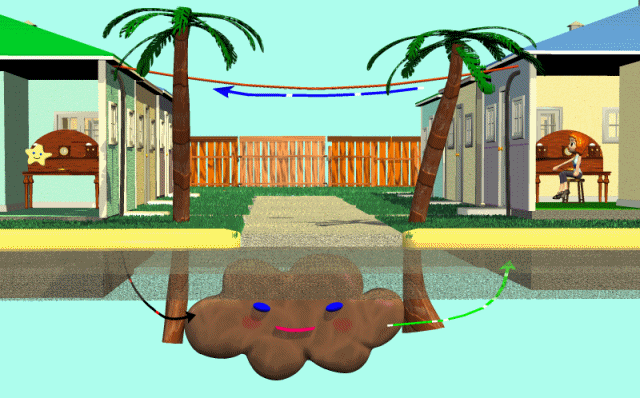Wednesday, March 04, 2020
Foreign meddling!
This time AI writer Dixon gets everything right, countermanding another writer who was getting it wrong.
 [Introducing a new character: HappyTruffle.]
In modern HV power lines, spike discharges often arc to nearby trees, causing acoustic 'pings' and occasional distortion of the power. Pine trees eat ions. When the trees grow toward the power lines to eat more ions, the trees are using natural intelligence to MEDDLE with the signal.
Here's a contrived example of a live bug in the system. Polistra is using the signal lantern to tell Happystar to RETREAT! The lightning bug thinks Polistra is a girl bug twerking at him, and flashes his assets in response. Happystar only sees the non-Morse repetitive flashing and figures Polistra is just keeping the lantern warm between messages.
[Introducing a new character: HappyTruffle.]
In modern HV power lines, spike discharges often arc to nearby trees, causing acoustic 'pings' and occasional distortion of the power. Pine trees eat ions. When the trees grow toward the power lines to eat more ions, the trees are using natural intelligence to MEDDLE with the signal.
Here's a contrived example of a live bug in the system. Polistra is using the signal lantern to tell Happystar to RETREAT! The lightning bug thinks Polistra is a girl bug twerking at him, and flashes his assets in response. Happystar only sees the non-Morse repetitive flashing and figures Polistra is just keeping the lantern warm between messages.
 = = = = =
Breaking news: Paleontologists have just discovered a network of communication wires among a population of pre-Cambrian rangeomorph fossils, which were somewhere between plants and animals in structure. The filaments are too narrow to be stolons carrying water and nutrition; they look more like ion-carrying signal wires.
= = = = =
Breaking news: Paleontologists have just discovered a network of communication wires among a population of pre-Cambrian rangeomorph fossils, which were somewhere between plants and animals in structure. The filaments are too narrow to be stolons carrying water and nutrition; they look more like ion-carrying signal wires.
In most software — and by “most” I mean nearly all — we call failures “bugs.” Bugs are things developers are expected to fix. If software has a bug, it’s broken and needs repair. Unless, of course, it is artificially intelligent software. Then, we may be told, it’s not broken. It’s “being deceptive.” Deception requires intention, purpose,…a mind. There is no mind present in the machine with the power to deceive. So when AI delivers a wrong, or unexpected, result, it is a bug.Yes. This is simple. Dixon gets it exactly right. Still, it raises a separate question. What if part of the system is genuinely alive and you don't realize it? In earlier telegraph systems, the earth was the return wire. Lots of living things are interpolated between sender and receiver, including some very BIG and very SIGNAL-INTENSIVE living things like the fungus networks that tie forests together. A mycorrhiza network could "eat" our signals and "poop" them out as altered signals to suit its own purposes. If it learned to eat at certain times of day when the most important signals (stock market closing reports) were coming through, the result would be genuinely intelligent.
 [Introducing a new character: HappyTruffle.]
In modern HV power lines, spike discharges often arc to nearby trees, causing acoustic 'pings' and occasional distortion of the power. Pine trees eat ions. When the trees grow toward the power lines to eat more ions, the trees are using natural intelligence to MEDDLE with the signal.
Here's a contrived example of a live bug in the system. Polistra is using the signal lantern to tell Happystar to RETREAT! The lightning bug thinks Polistra is a girl bug twerking at him, and flashes his assets in response. Happystar only sees the non-Morse repetitive flashing and figures Polistra is just keeping the lantern warm between messages.
[Introducing a new character: HappyTruffle.]
In modern HV power lines, spike discharges often arc to nearby trees, causing acoustic 'pings' and occasional distortion of the power. Pine trees eat ions. When the trees grow toward the power lines to eat more ions, the trees are using natural intelligence to MEDDLE with the signal.
Here's a contrived example of a live bug in the system. Polistra is using the signal lantern to tell Happystar to RETREAT! The lightning bug thinks Polistra is a girl bug twerking at him, and flashes his assets in response. Happystar only sees the non-Morse repetitive flashing and figures Polistra is just keeping the lantern warm between messages.
 = = = = =
Breaking news: Paleontologists have just discovered a network of communication wires among a population of pre-Cambrian rangeomorph fossils, which were somewhere between plants and animals in structure. The filaments are too narrow to be stolons carrying water and nutrition; they look more like ion-carrying signal wires.
= = = = =
Breaking news: Paleontologists have just discovered a network of communication wires among a population of pre-Cambrian rangeomorph fossils, which were somewhere between plants and animals in structure. The filaments are too narrow to be stolons carrying water and nutrition; they look more like ion-carrying signal wires.Labels: Morsenet of Things, Not AI point-missing
